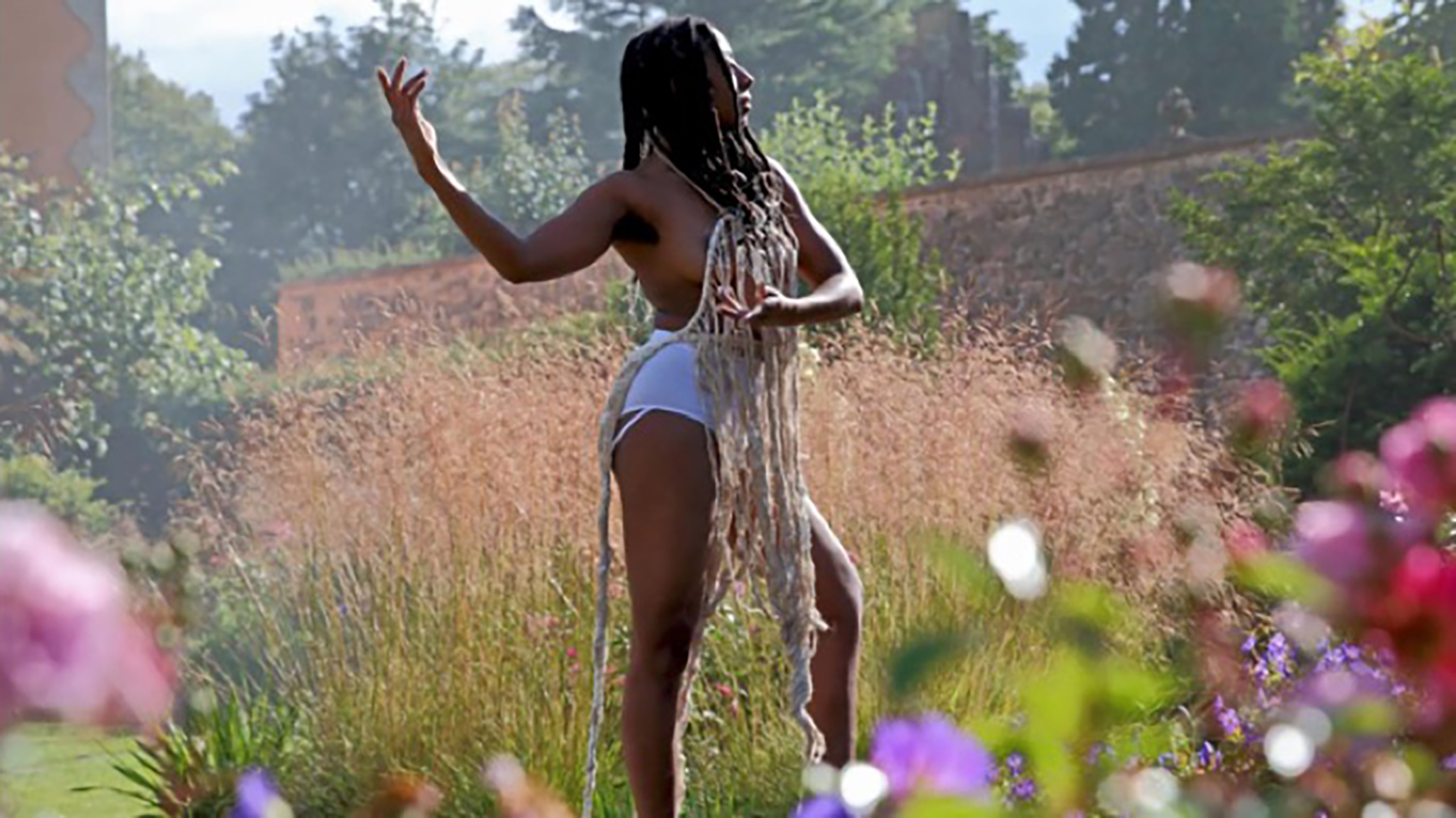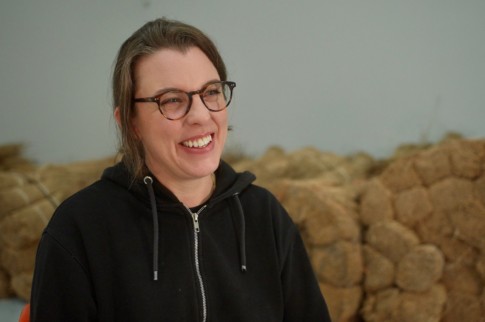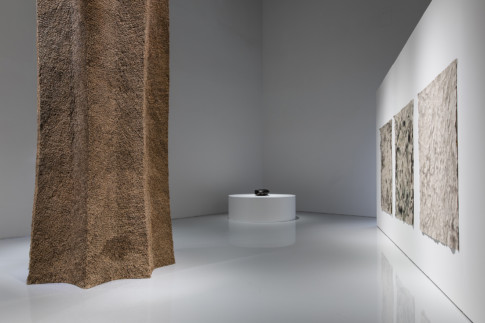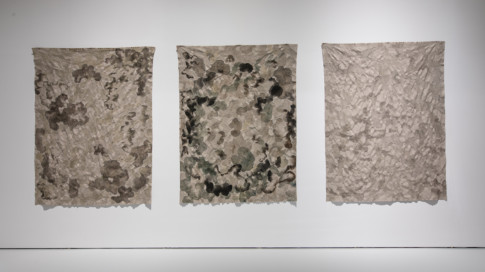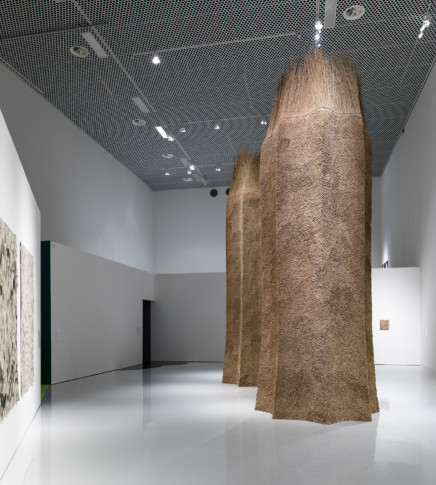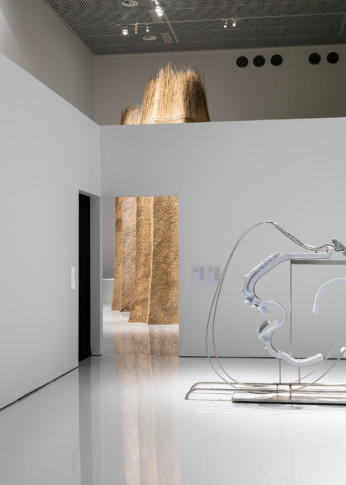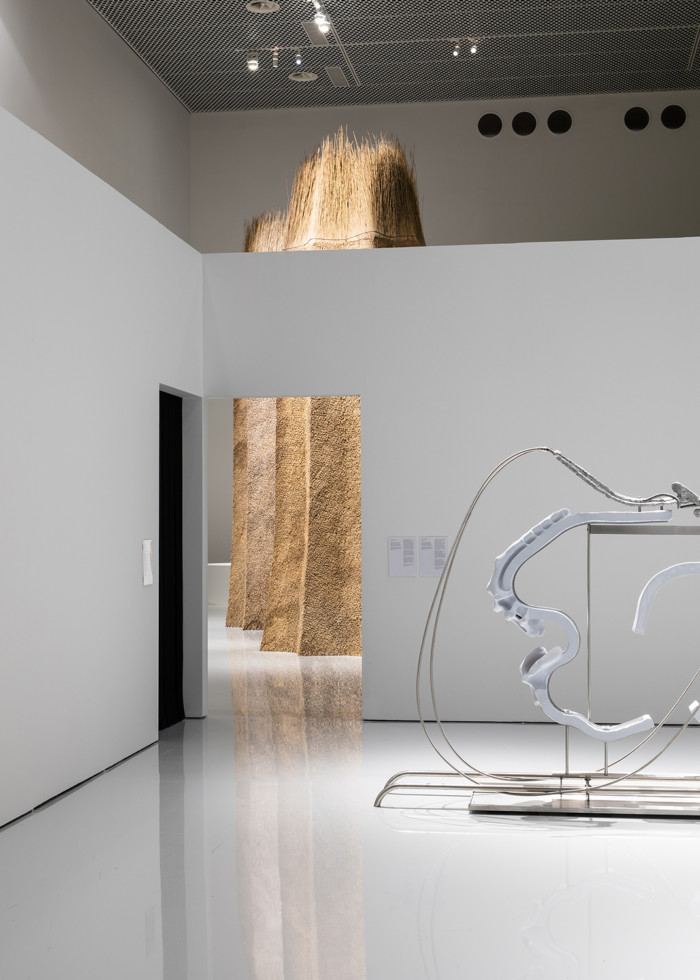
Installation view, 2022 Photo: Helene Toresdotter
About the works
Isabelle Andriessen
The Enchanters, 2022
Produced for the exhibition with support from Mondriaan Fund, The Netherlands
Isabelle Andriessen has for Twilight Land created a monumental sculptural installation, forming an integral but alien part of the museum’s architectural structure. Its’ ceramic components bear traces of unknown anatomies and metabolisms, allowing for associations to fragments of organs, jawbones, ligaments and vertebrae. The shapes are jointed up onto a stain-less steel construction that carry aluminium elements which sweat, in turn causing the ceramics to ooze and crystalise.
Andriessen’s work inhabits a liminal space between sculpture and performance. The different materialities penetrate, cling to, and react with one another. They respond to the surrounding atmosphere while triggering chemical processes within each other – manifesting their agency through continuous interaction and change.
As uncanny amalgamations of mechanical remnants, fossil formations, and chemical waste, these performing sculptures obscure the interface between the animate and inanimate, while offering a glimpse into a future reality in which new entanglements are flourishing in a world without humans.
Isabelle Andriessen was born in Haarlem in the Netherlands. She lives in Amsterdam.

Yael Bartana
Two Minutes to Midnight, 2021
Yael Bartana made her first extensive solo exhibition with Moderna Museet Malmö in 2010. For Twilight Land she returns to the museum with Two Minutes to Midnight. In the film we encounter the entirely female government of an imaginary nation. To deal with an increasing threat from a hostile nuclear power, the female government gathers in its “peace room” – as opposed to Dr. Strangelove’s toxically masculine “war room” in Stanley Kubrick’s classic Cold-War satire.
The government representatives confer with a number of female experts – defence advisors, lawyers, psychologists, peace activists and politicians, (real experts) who play themselves in the film. Their discussions are influenced by the stress of acting in time before the Doomsday Clock (a symbol of our human potential for self-destruction) strikes midnight.
Two Minutes to Midnight is the result of a four-year interdisciplinary process in which Bartana analysed the macho structures of the geopolitical power play. The imagery comes from footage of the experimental live performances What if Women Ruled the World? in Aarhus and Berlin (2017 and 2018 respectively) and the performance Bury Our Weapons Not Our Bodies in Philadelphia (2019).
Yael Bartana was born in Israel in 1970. She lives in Berlin and is currently doing a PhD at Malmö Art Academy.
Two Minutes to Midnight is shown 20 Oct 2022 – 8 Jan 2023.
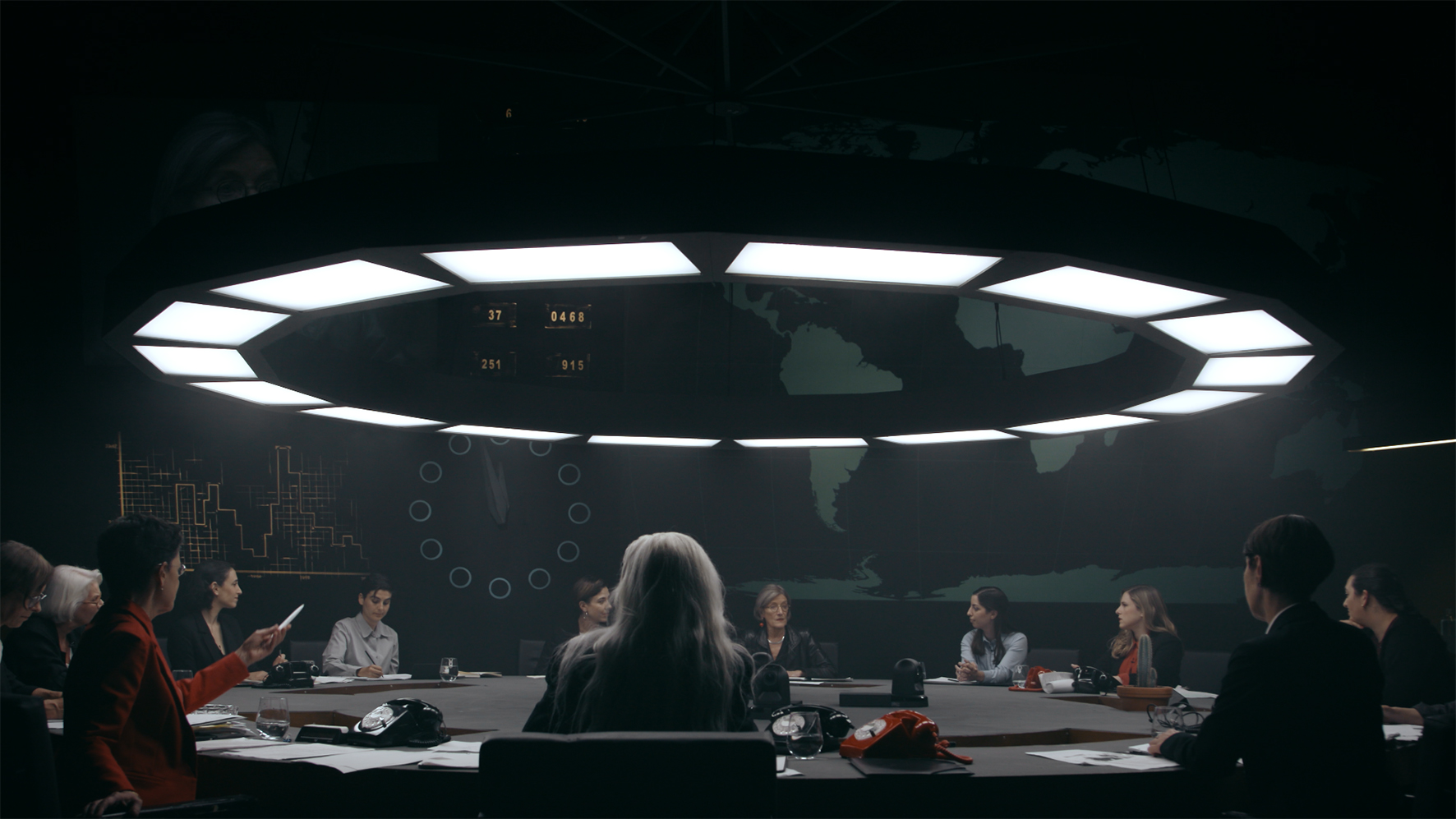
Gallery, Capitain Petzel and Celilia Hillström Gallery
Rose-Marie Huuva
Ijár, 2005
Part of the Moderna Museet Collection. Aquisition 2022 with funds from the Gerard Bonniers foundation.
Rose-Marie Huuva’s sculptural objects can give the impression of being alive, of having a soul. Perhaps it is the unexpected juxtaposition of materials that gives rise to this feeling. In the work Ijár, a rounded shape made of reindeer hide merges with black seal fur. From a distance the mottled hide can appear like polished stone, while the seal fur can be mistaken for a dark cavity.
The title Ijár, is a word that Huuva invented herself. It has a kinship, however, to the Sámi word idja, meaning night sky. The title can by association enable us to see astronomical light phenomena in the reindeer hide, causing microcosm to shift over into macrocosm.
Only the artist herself knows the exact technical process behind her artworks, experimentally developed as they are, from Sámi craftsmanship and culture. Rose-Marie Huuva is also a poet whose breakthrough came with the poetry collection Galbma Rádná published in 1999, a book that was nominated for the Nordic Council Literature Prize.
Rose-Marie Huvva was born 1943 within the Sámi village Gabna. She lives in Giron (Kiruna).
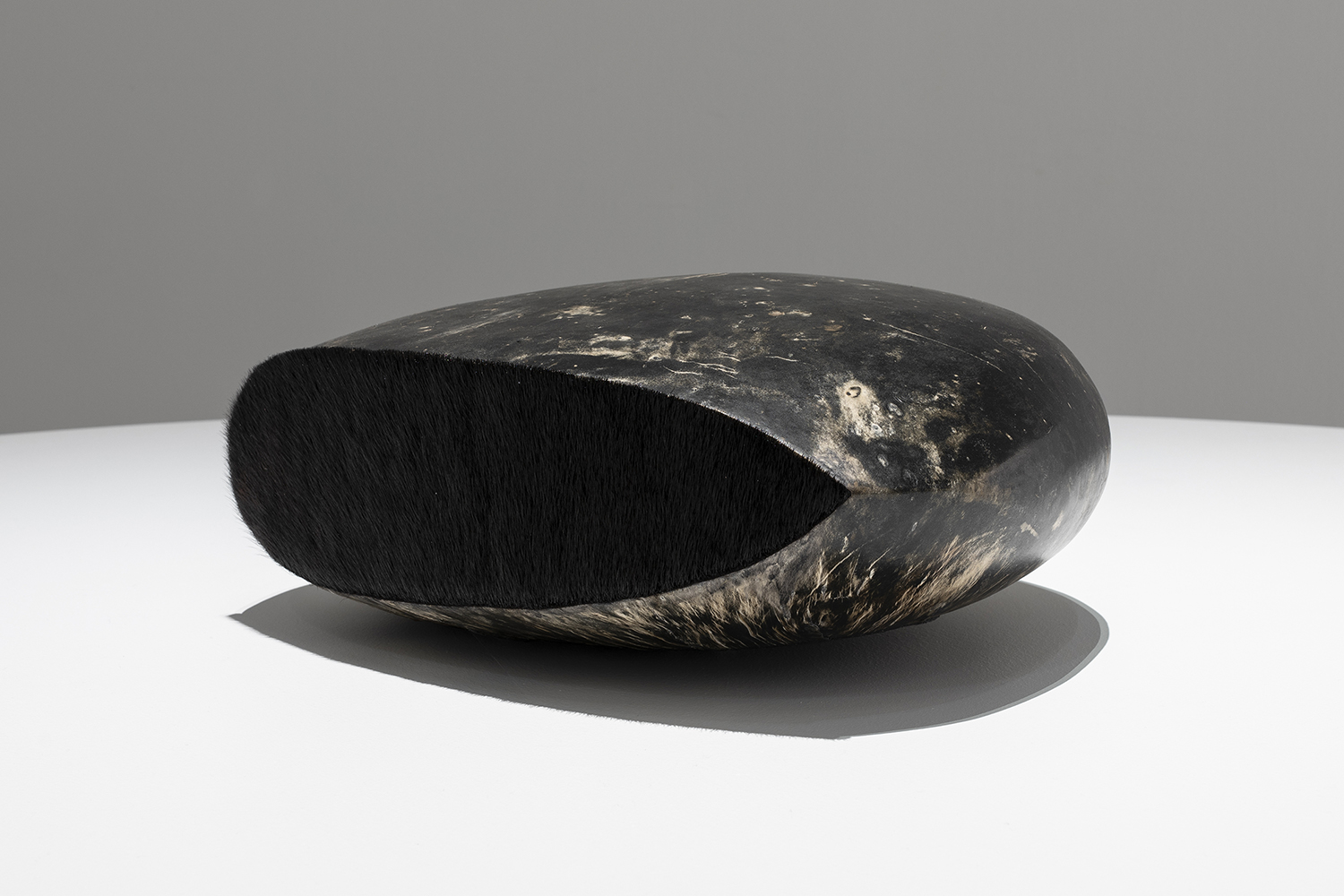
Anna Ling
Zostera Marina (eelgrass) #1, #2, #3, 2021
Part of the Moderna Museet Collection. Purchase 2021 (Swedish acquisition 2021). Donation 2021 by the artist.
These ink washes on linen depict Bohus County’s fields of marine eel grass seen from above, through the water surface. The translucent layers of colour capture the feeling of looking down into the water plants’ undulating mass of foliage. At the same time, the canvases have a certain military feel to them. They are reminiscent of camouflage and one could associate them with some sort of functional textile that has been left out to dry as a unit sets up camp for the night.
The eel grass fields are often referred to as the ocean’s “nursery” since they form an important habitat for juvenile fish and other marine animals. Due to increased industrialisation and over-fertilisation in agriculture, eel grass fields have been drastically reduced in recent years. Currently a painstaking re-planting project is underway, in which every individual shoot is planted by hand by a diver.
Anna Ling was born 1971 in Gothenburg, Sweden. She lives in Malmö.
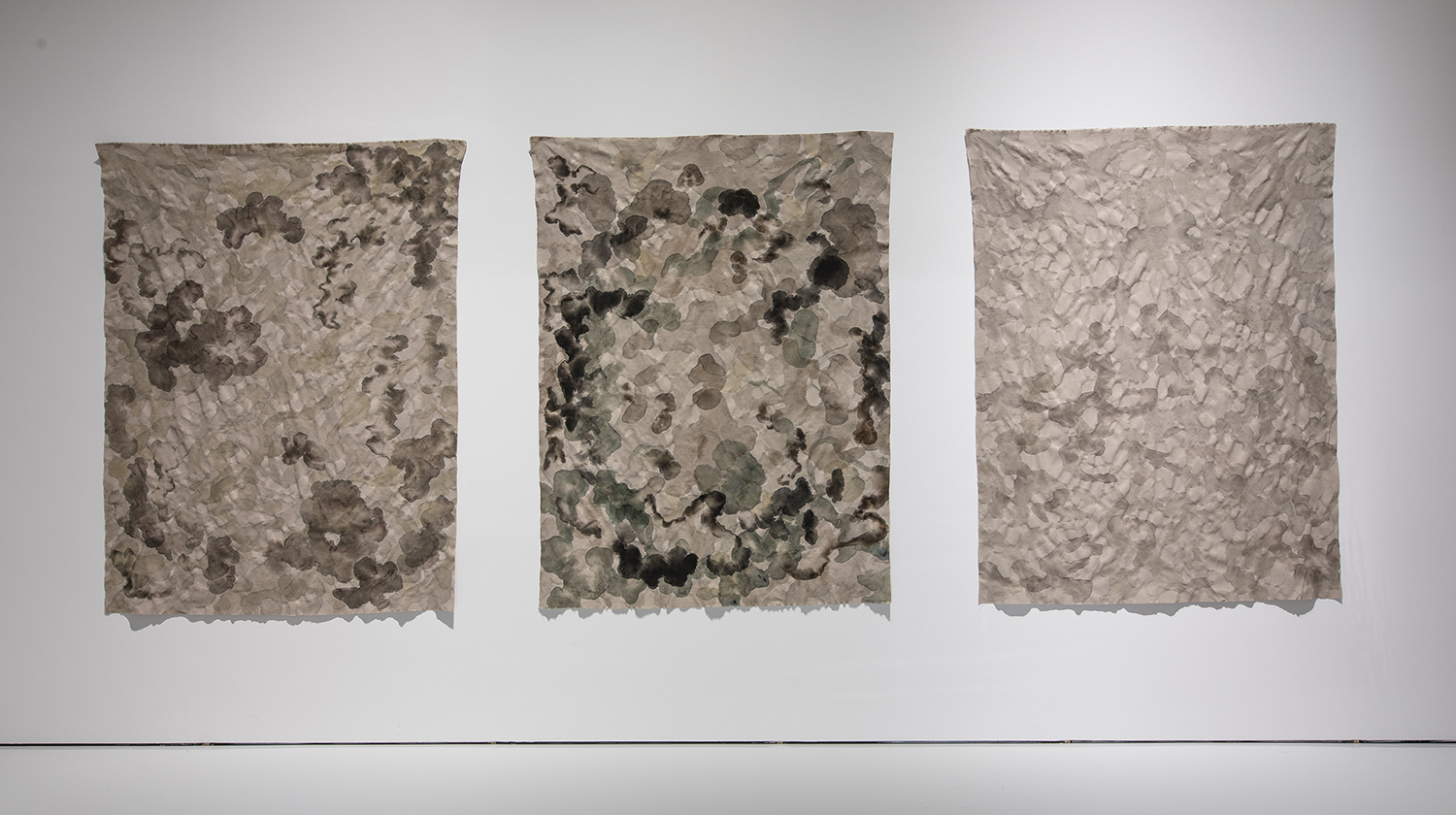
Aernout Mik
Threshold Barriers, 2022
In Aernout Mik’s video installations, we encounter staged situations where established hierarchies and roles have been disrupted. The people in his films seem to populate the gap between different social systems and world views. Shifts in norms and changed power relations create new behaviours and group dynamics.
The police and the activists in Threshold Barriers are both exhausted and full of anticipation. Their manners oscillate between resolve and confusion, between aggression and consideration. One minute they are trying out a new approach, the next they are falling back into their ingrained roles.
Together they move around in a jumble of riot barriers, a kind of architecture of power. These barriers strongly affect people’s actions and relationships but can always be rearranged for new purposes.
Aernout Mik was born in 1962 in Groningen, in the Netherlands. He lives in Amsterdam.
Threshhold Barriers is shown 13 January – 12 March 2023.
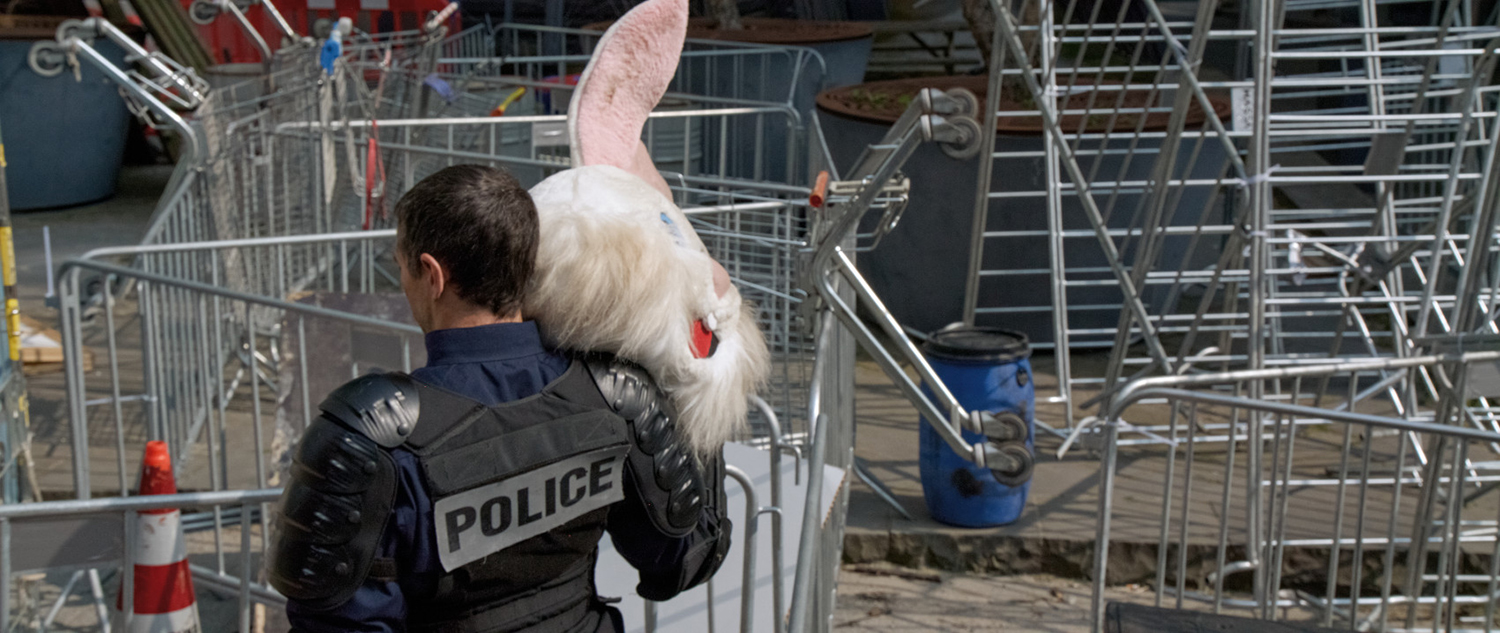
Sandra Mujinga
Pervasive Light, 2021
Three vertically raised screens, installed like a religious triptych. Emerging from the darkness is a figure dressed in reflective camouflage. The figure does not meet our eye and does not seem to be aware of our presence. With rhythmic movements it pulsates in and out of the compact darkness while the edging of its coat creates undulating patterns across the screens.
Pervasive Light is partially inspired by how deep-sea creatures living so far under the water surface that sunlight cannot reach them, create their own light through bioluminescence. In Mujinga’s imaginary universe this self-produced light becomes both a political and a poetic metaphor for an inner, unexplored potential, as well as for our ability of maneuvering in the dark.
Sandra Mujinga was born in 1989 in the Democratic Republic of Kongo. She is a Norwegian artist residing in Oslo and Berlin
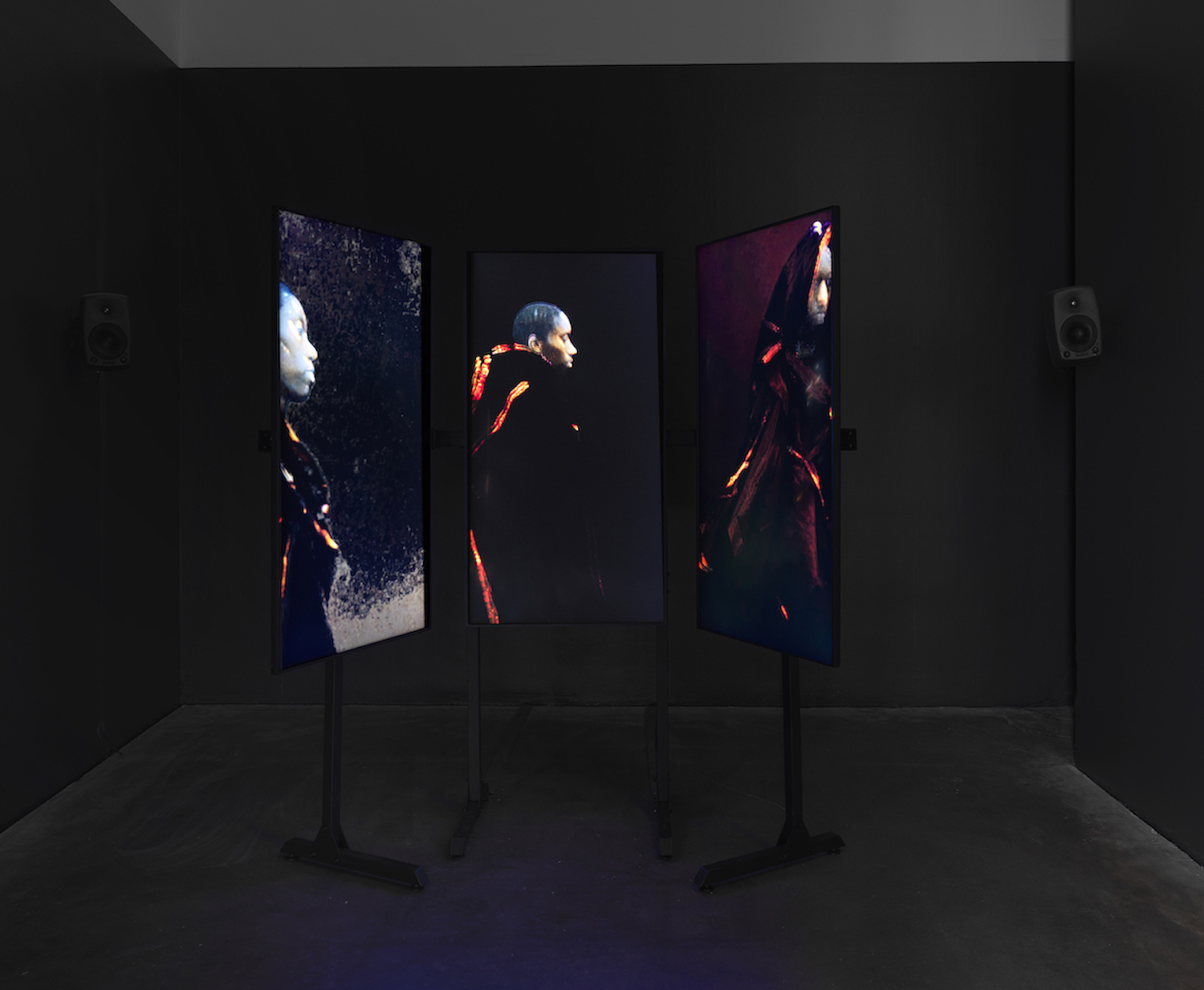
Ingrid Elsa Maria Ogenstedt
Towers, 2022
Reed-work by Thatchers, Bjarne Johansen, Jeffery Joel Brankley
Produced for the exhibition Twilight Land
For Twilight Land, Ogenstedt has created two towers that extend upwards to the ceiling of the museum’s large exhibition space. Historically, towers have been built for defence purposes. With a good view of the surroundings, enemy activity can be detected at an early stage. Towers also manifest power and can effectively signal the strength and potency of a society or an individual. Ogenstedt’s structures differ, however, from urban skyscrapers made of steel and glass. Built from tightly joined reeds they rather appear like strange beings, deeply rooted in a natural landscape that has become increasingly alien to us.
The towers are formally inspired by the Himalayan Towers, which are assumed to be between 500 to 2000 years old – survivors of generations, conflicts, and earthquakes – and whose original function is long forgotten. As twin towers they may also bring to mind the World Trade Center in New York, which collapsed in the terrorist attacks at the beginning of this millennium. In silent stillness, these mysterious monoliths speak of the transience of civilisations, of the fragility of life and the course of nature.
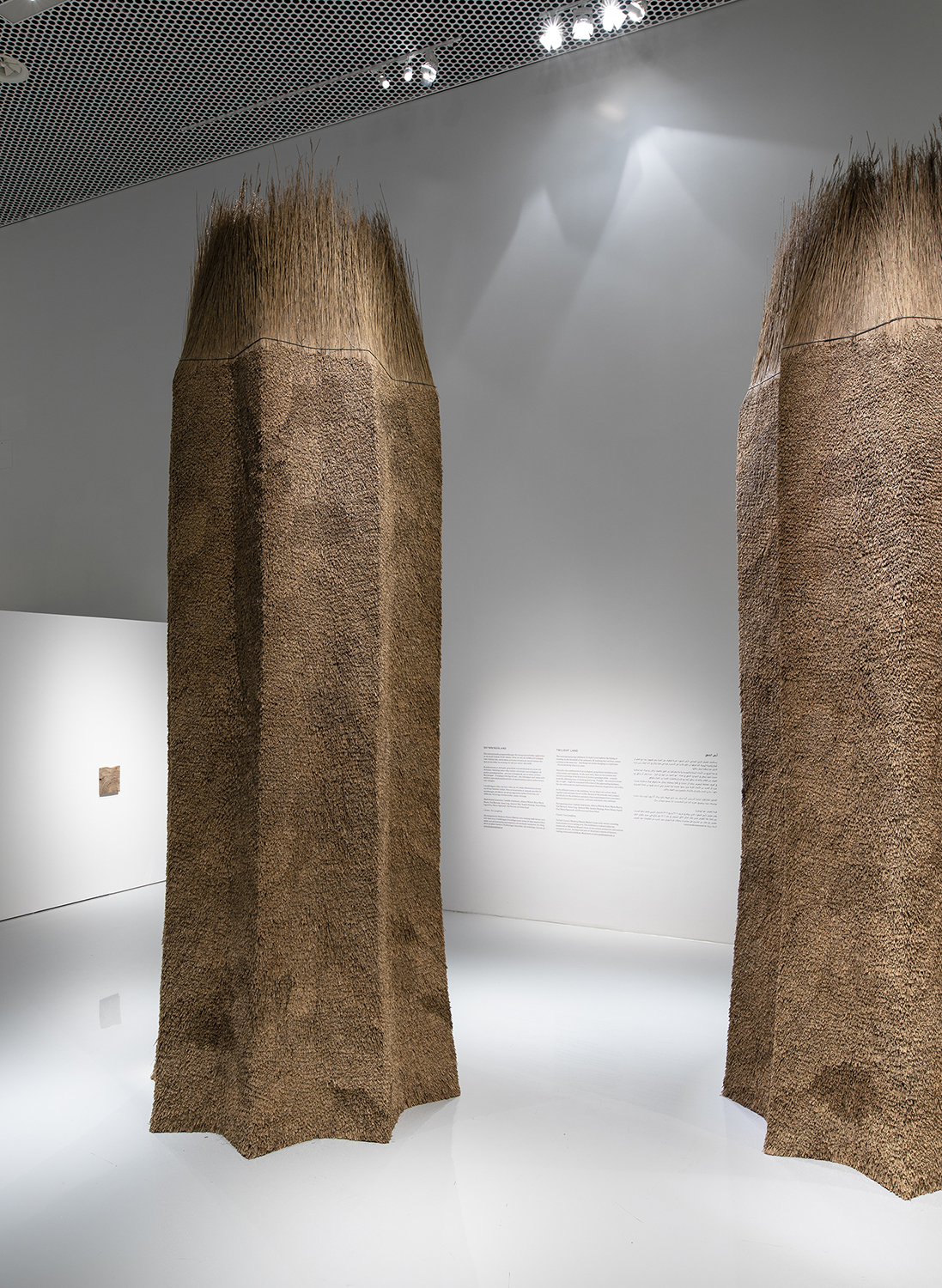
Organ, 2022
Produced for the exhibition Twilight Land
An organic form in a state of growth – upwards, downwards, inwards and outwards. It exists in the borderland between natural form and human construction. It reaches upwards towards the sky, feeling around to see how it will continue growing. In a dried state, it awaits the next opportunity to continue, the next rain, the next flood.
Clay soils are ancient seabeds and lake floors that were formed both during and after the ice age. As the fine-grained product of weathering, it can be transported relatively far from its place of origin since the particles are carried by water currents out to sea or to larger lakes where it can form substantial deposits.
Like reeds and grass, clay is found in building traditions around the world, both in present times and historically. Even modern building techniques are based on qualities that we have learned from clay. Organ is thus just as rooted in our cultural heritage as it is in nature. Perhaps it even embodies the impossibility of separating the two? As viewers, we breath in its scent and encounter its body with our own.
Ingrid Ogenstedt was born in Stockholm in 1982 and currently lives and works in Berlin.
The work Organ is shown until 12 March 2023.
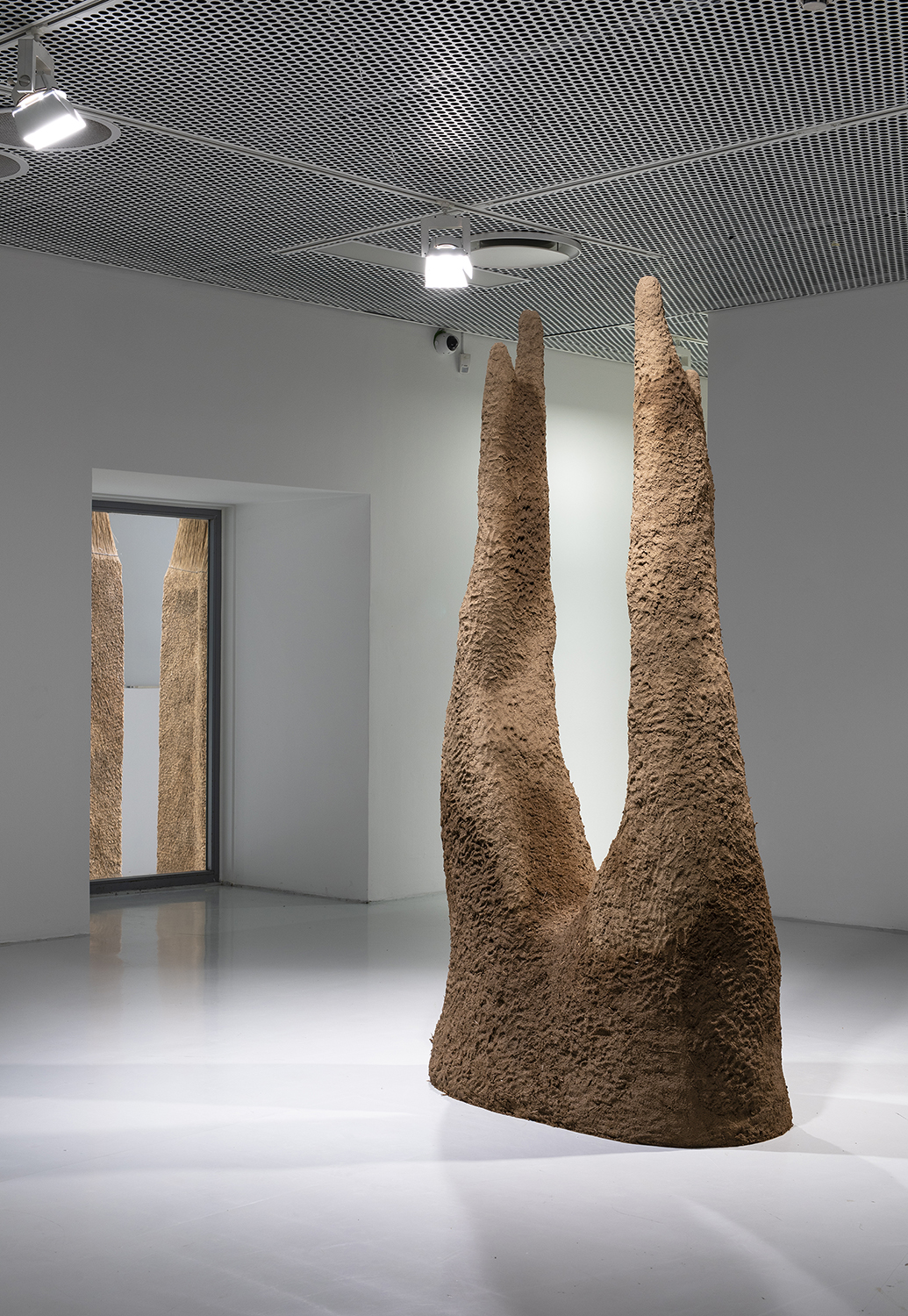
Ida Persson
Anticipator, 2022
Produced for the exhibition Twilight Land
With clinically smooth surfaces and mechanical exactitude, Ida Persson’s painted structures, devices and monumental facades can evoke feelings of trust and safety, but also the opposite: vulnerability and violence.
The viewer encounters the paintings slightly from below, which gives the impression of the motifs looming over one like tall constructions and building complexes. Sometimes architectural or mechanical elements have acquired human or more-than-human traits. As if the architecture has become a part of the body or as if the body has been incorporated into a machine.
On closer inspection the precision starts to warp. The brushstrokes are unsteady and in the grooves between the joined parts, appears traces of red paint or blood. The organic, unruly, and dirty life – that has been tamed, domesticated and built away – is constantly threatening to break free or seep through.
Ida Persson was born in 1985 in Ystad. She has lived in Malmö for a long time but has recently moved back to Ystad.
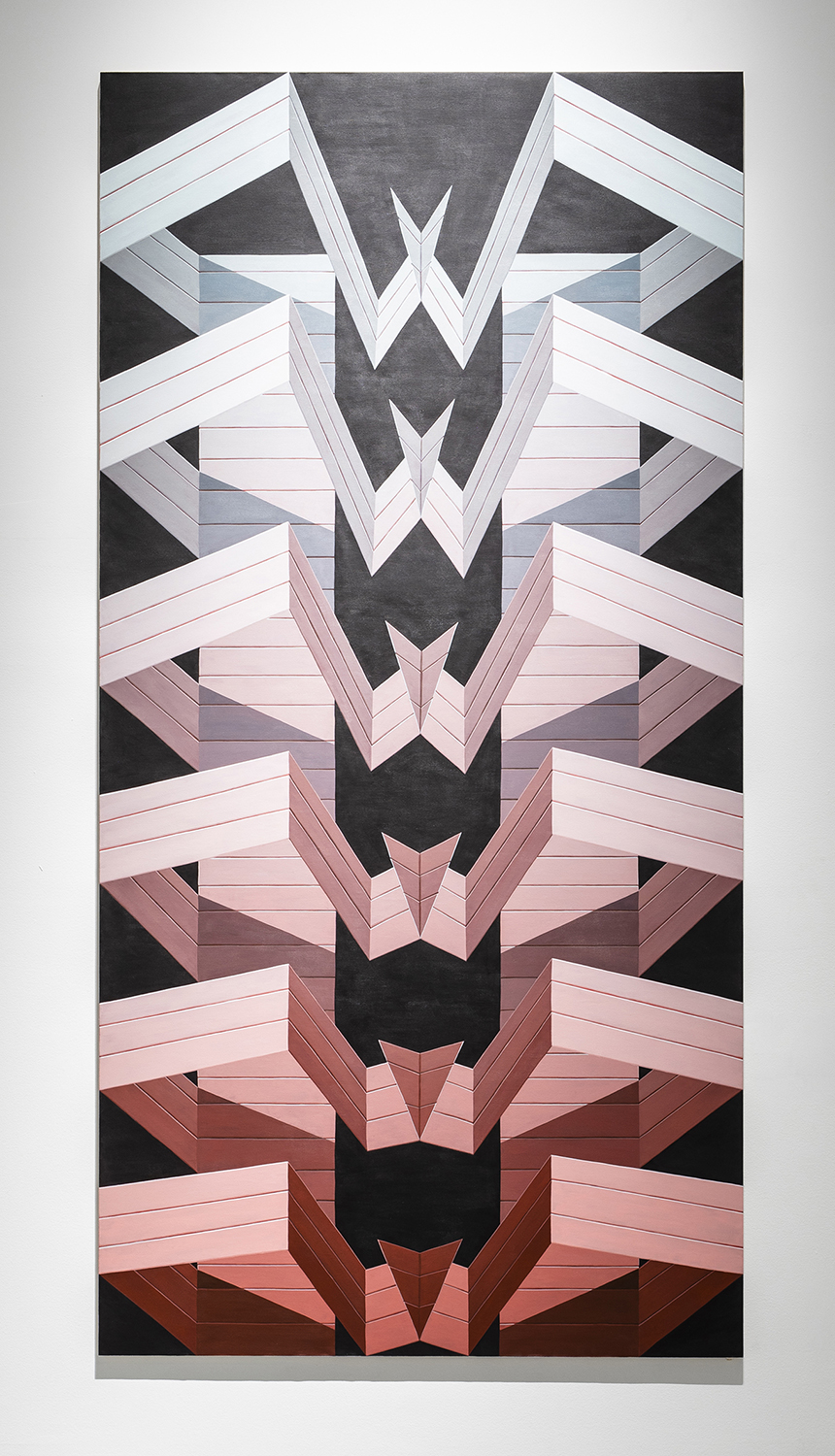
Stina Siljing
I Count to 27, 2021
Part of the Moderna Museet Collection. Purchase 2021 (Swedish acquisition 2021)
Thoughts on the fragility of life and what remains when it ends are prominent strains in Siljing’s practice. In her painting she has worked with cell structures, the building blocks that are the foundation of all life, as well as organic material that bears traces of vanished existences.
In I Count to 27, Siljing has counted the year rings in a piece of elm wood. The twenty-seventh ring she has engraved and filled with silver leaf. The work belongs to a series she made to process her loss and grief after her son’s suicide.
For the exhibition Twilight Land, the work brings with it its own story, the grief and reflections on the fragility of life. It can also raise thoughts on mental and ecological health, as well as the connections between the two.
Stina Siljing was born in 1962. She lives in Kalmar.
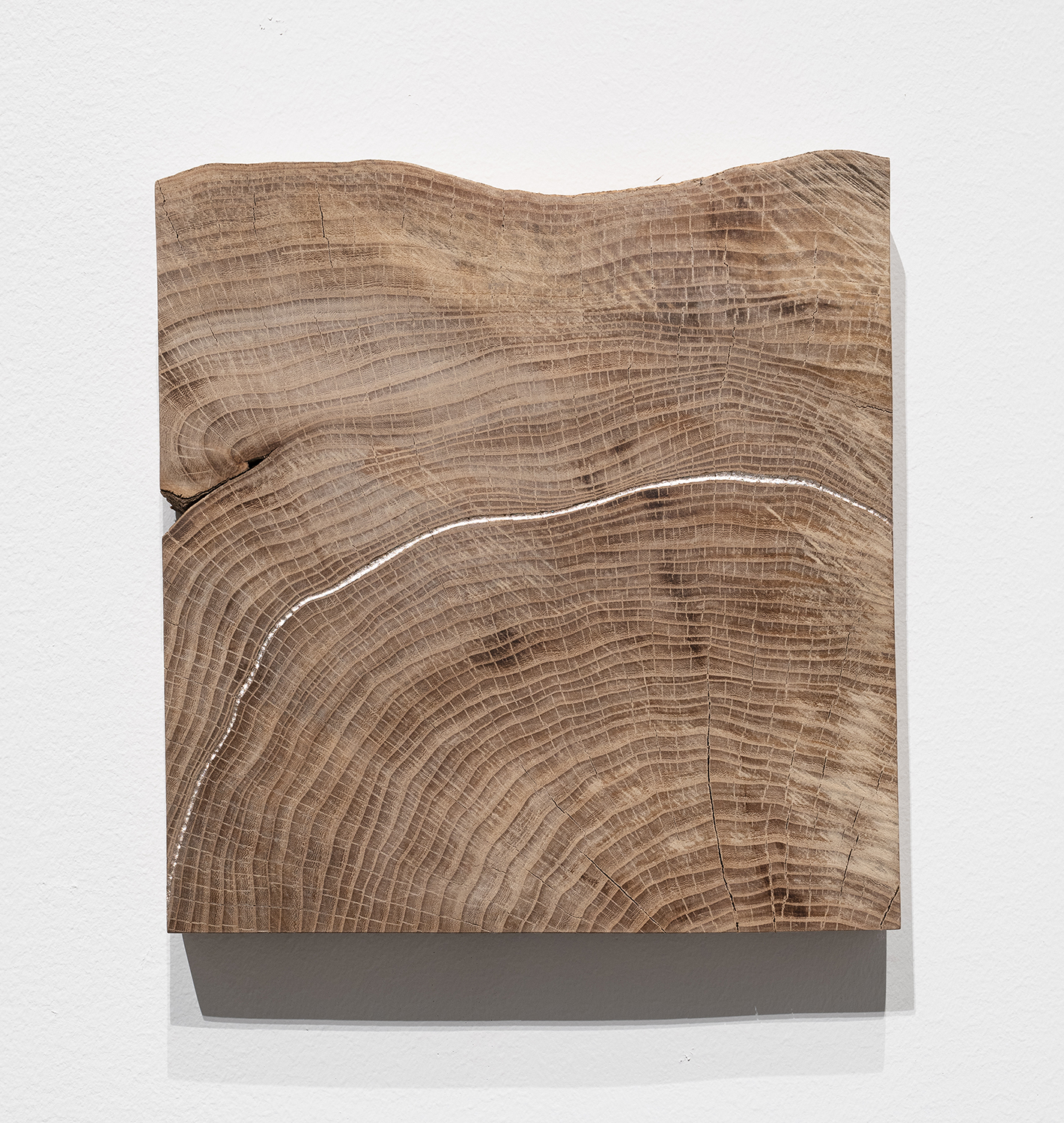
Jonas Staal
Climate Propagandas, Video Study, 2020
In Climate Propagandas, Video Study the artist Jonas Staal explores how the climate crisis has been interpreted, described and instrumentalised in different ideological contexts.
In the video, we learn how some political factions tend to place responsibility for the ecological collapse on the individual rather than on the large, resource-sapping corporations. Or how others see the crisis as an opportunity – a new, valuable resource for geomarkets and the colonisation of other planets. There are also those who argue that all this talk about climate change is a sham, with the aim of maintaining power and control. In addition, there is another grouping, on the far right, that wants to use it as an opportunity to discuss who, in case of an ecological collapse, has the right to survive and who doesn’t.
Towards the end of the film, the tempo slows and as a viewer we glide into what seems to be an alternate vision, of a time and a place where different forms of more-than-human life have managed to recover and where humans are no longer at the centre.
Jonas Staal was born in Zwolle, Netherlands, in 1981. He lives in Rotterdam and Athens.

Alberta Whittle
RESET, 2021
Love as a force of resistance in times of great difficulties, appears as a common thread throughout Alberta Whittles cinematic collage, created through music, dance, poetry and text. The work was filmed at the height of covid-19 lockdown, across Scotland, South Africa and Barbados, responding to the immediate context of the Black Lives Matter movement, the global pandemic and climate emergency. It is informed by the writings of queer theorist, Eve Kosofsky Sedgwick, interweaving gothic imagery, fears of contagion, xenophobia and the ensuing moral panic that often follows such anxieties. Exploring timely questions relating to personal healing and the cultivation of hope in hostile environments, this political film features moments of grief and reflection, but also manifestations of empathy and desire.
Alberta Whittle, was born 1980 in Bridgetown, Barbados. She lives in Glasgow, Scotland. RESET was co-produced and co-commissioned by Frieze and Forma for the Frieze Artist Award 2020.
